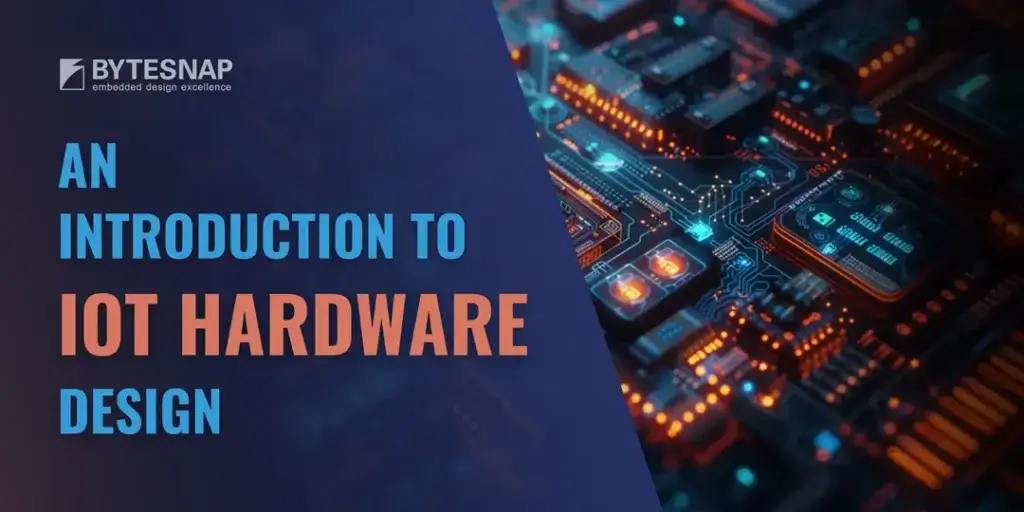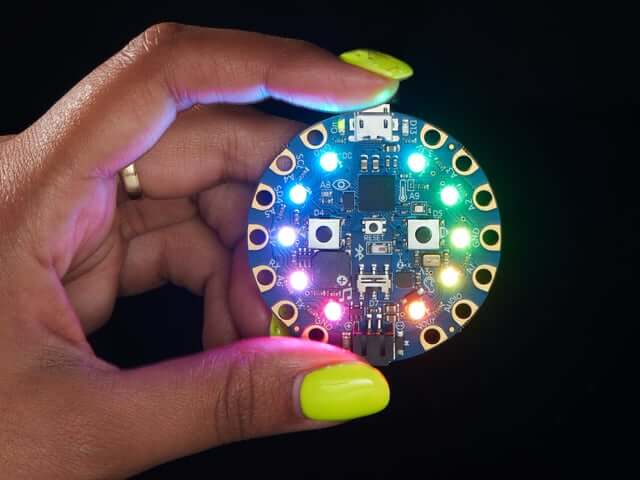IoT Hardware Design Explainer
In the Internet of Things (IoT) sector, hardware design plays a crucial role in determining the success and functionality of smart devices.
Understanding the key considerations and best practices in IoT hardware design is essential for developers and companies looking to create innovative, efficient, and reliable connected products.

Essential IoT Hardware Components
The foundation of any IoT project is built upon carefully selected hardware components.
Let’s examine some key elements that power modern IoT devices:
Microcontrollers and Single-Board Computers
At the heart of IoT devices, we find powerful yet compact computing solutions:
These powerful boards provide the processing capability needed for complex IoT applications, from data collection to edge computing.
Detailed Component Breakdown
Let’s delve deeper into the key components that make up IoT devices:
1. Microcontrollers (MCUs) and System-on-Chip (SoC)
MCUs and SoCs serve as the brains of IoT devices, integrating several components into a single chip:
- CPU: Often based on ARM Cortex-M series (e.g., M0+, M3, M4, M7) or RISC-V architectures
- Memory: On-chip RAM and flash memory for programme storage and execution
- Peripherals: Integrated components like ADCs, DACs, timers, and communication interfaces (UART, SPI, I2C)
Popular options include:
- ESP32 (dual-core, Wi-Fi + Bluetooth)
- Nordic nRF52 series (Bluetooth Low Energy focused)
- STM32 series (wide range of options)
- TI CC3220 (Wi-Fi focused)
2. Sensors
Sensors are crucial for IoT devices to interact with the physical world. Common types include:
- Environmental: Temperature, humidity, pressure, air quality
- Motion: Accelerometers, gyroscopes, magnetometers
- Optical: Ambient light, IR, UV
- Proximity and distance: Ultrasonic, LiDAR, ToF (Time of Flight)
- Biometric: Heart rate, blood oxygen, fingerprint
- Chemical: Gas sensors, pH sensors
3. Actuators
Actuators allow IoT devices to affect the physical world. Examples include:
- Motors: DC, stepper, servo
- Solenoids
- Relays
- Piezoelectric actuators
- Pneumatic or hydraulic systems
Connectivity Modules
IoT devices rely on various connectivity options to communicate data:
- Wi-Fi and Bluetooth modules for short-range, high-bandwidth applications
- Cellular (NB-IoT, LTE-M, 5G) for long-range, wide-area coverage
- LoRa/LoRaWAN for long-range, low-power wide area networks
- Zigbee for mesh networking in home automation
- Thread for IPv6-based mesh networking in smart homes
- NFC for short-range, low-power secure transactions
The choice of connectivity module depends on factors such as power consumption, range requirements, and data transfer
rates.
Power Management Systems
Efficient power management is crucial for IoT devices, especially those deployed in remote locations. Key components
include:
- Battery management ICs: For charging and monitoring battery levels
- Voltage regulators: To provide stable power to various components
- Power distribution switches: For selective power control
- Energy harvesting circuits: To capture energy from the environment (solar, vibration, RF)
Security Hardware
With increasing focus on IoT security, dedicated hardware is often included:
- Secure elements: Tamper-resistant storage for cryptographic keys
- Trusted Platform Modules (TPM): For secure boot and attestation
- Hardware cryptographic accelerators: For efficient encryption/decryption
- Physical Unclonable Functions (PUFs): For unique device identification
The careful selection and integration of these components are crucial in creating effective, efficient, and secure IoT devices.
The specific choices depend on the application requirements, target environment, cost constraints, and performance needs of the IoT solution being developed.
Key Considerations for IoT Hardware Design
When designing IoT hardware, several factors must be taken into account to ensure optimal performance and user experience:
1. Power Efficiency and Battery Life
One of the most critical aspects of IoT hardware design is power efficiency. Many IoT devices operate on battery power, making it essential to optimise energy consumption to extend battery life.
This involves selecting low-power components, implementing efficient power management techniques, and optimising software algorithms to minimise energy usage.
2. Size and Form Factor
The physical dimensions and design of an IoT device can greatly impact its usability and adoption.
Designers must balance functionality with compactness, ensuring that the device fits seamlessly into its intended environment while
still accommodating all necessary components.
3. Connectivity Options
Choosing the right communication protocol is crucial for IoT devices. Factors such as range, power consumption, data rate, and network infrastructure must be considered when selecting between options like Wi-Fi, Bluetooth, LoRa, Zigbee, or cellular technologies.
The selection of an appropriate communication protocol is critical in IoT device design for several reasons:
- Power Efficiency: Different protocols have varying power requirements. For battery-operated devices, low-power protocols like Bluetooth Low Energy (BLE) or LoRaWAN can significantly extend battery life.
- Range Requirements: The physical distance between devices and gateways/servers dictates protocol choice. While Wi-Fi is suitable for home environments, cellular or LoRa may be necessary for long-range applications in rural or industrial settings.
- Data Throughput: The amount and frequency of data transmission vary by application.
High-bandwidth protocols like Wi-Fi are suitable for video streaming, while low-bandwidth options suffice for simple sensor data. - Network Topology: Some protocols support mesh networking (e.g., Zigbee, Thread), which can extend range and improve reliability in certain scenarios.
- Scalability: Scalable protocols are very useful in IoT. Technologies like NB-IoT are designed to handle massive numbers of connected devices.
- Security: Different protocols offer varying levels of built-in security. This is crucial for protecting sensitive data transmitted by IoT devices.
- Interoperability: Choosing widely-supported protocols ensures your device can communicate with a broader ecosystem of products and services.
- Cost: Both hardware and potential subscription costs (e.g., for cellular connectivity) should be considered in protocol selection.
- Regulatory Compliance: Certain frequencies and protocols are regulated differently across regions, affecting global deployability.
To illustrate the impact of protocol choice, consider these scenarios:
Scenario A: Smart Home Sensor
Protocol: Zigbee
- Low power consumption
- Mesh networking for reliable coverage
- Sufficient for periodic sensor readings
- Interoperable with many smart home systems
Scenario B: Industrial Monitoring
Protocol: LoRaWAN
- Long-range capability (up to several km)
- Very low power consumption for battery life of years
- Suitable for infrequent, small data transmissions
- Cost-effective for large-scale deployments
As demonstrated, the choice of protocol significantly influences the device’s capabilities and suitability for its intended application.
Careful consideration of these factors ensures that IoT devices can efficiently and effectively fulfil their intended roles within the broader IoT ecosystem.
4. Security Features
With the increasing number of connected devices, security is paramount in IoT hardware design. Implementing robust security measures, such as encryption, secure boot, and tamper detection, helps protect both the device and the data it transmits.
5. Scalability and Future-proofing
Designing IoT hardware with scalability in mind ensures that devices can adapt to future requirements and technological advancements.
This may involve using modular designs, over-the-air update capabilities, and selecting components with long-term availability.
The IoT Hardware Design Process
Developing IoT hardware involves a series of steps and best practices to ensure a successful product:
1. Prototyping and Testing
Creating prototypes and conducting thorough testing is essential for identifying and resolving issues early in the development process.
Rapid prototyping techniques can help accelerate this phase and reduce time-to-market.
2. PCB Design Considerations
Printed Circuit Board (PCB) design is a critical aspect of IoT hardware development. Factors such as component
placement, signal integrity, and thermal management must be carefully considered to ensure optimal performance and
reliability.
3. Software Integration and Development
IoT devices require seamless integration between hardware and software components. Embedded firmware
development and the use of specialised development tools are crucial for creating efficient and reliable IoT
solutions.
4. Regulatory Compliance and Certifications
Ensuring that IoT devices meet relevant regulatory standards and obtain necessary certifications is essential for market compliance and user safety. This may include certifications for electromagnetic compatibility (EMC), radio frequency (RF) emissions, and product-specific standards.

Emerging Trends in IoT Hardware Design
The field of IoT hardware design is rapidly evolving, driven by technological advancements and changing market
demands. Several key trends are shaping the future of IoT devices:
1. Edge Computing
Edge computing is becoming increasingly crucial in IoT architectures, allowing for data processing closer to the
source of data generation. This trend significantly reduces latency and bandwidth usage, enabling real-time
decision-making capabilities.
- According to Shi et al. (2016), edge computing can reduce response time and network bandwidth consumption compared
to cloud computing in IoT scenarios. - Research by Satyanarayanan (2017) highlights the importance of edge computing in supporting real-time cognitive
assistance applications in IoT.
2. AI and Machine Learning Integration
The integration of AI and machine learning capabilities into IoT devices is rapidly growing, enabling smarter and
more autonomous operations.
- Mohammadi et al. (2018) discuss the convergence of IoT and machine learning, highlighting how it enables devices
to learn from data and improve their performance over time. - A study by Zhou et al. (2019) explores the implementation of deep learning models on edge devices for IoT
applications, demonstrating the feasibility of running complex AI algorithms on resource-constrained hardware.
3. 5G Integration
The rollout of 5G networks is set to revolutionise IoT connectivity, offering higher bandwidth, lower latency, and
support for a massive number of connected devices.
- Palattella et al. (2016) discuss how 5G technologies will enable new IoT use cases and applications, particularly
in areas requiring ultra-reliable and low-latency communications. - Research by Akpakwu et al. (2018) provides a comprehensive survey of 5G technologies for IoT, highlighting the
potential for massive machine-type communications.
4. Energy Harvesting and Efficient Power Management
As IoT devices proliferate, energy efficiency and alternative power sources become increasingly important. Energy
harvesting technologies are being integrated into IoT hardware designs to extend battery life or enable self-powered
operation.
- Shaikh and Zeadally (2016) provide an overview of energy harvesting techniques for IoT devices, discussing various
sources such as solar, thermal, and RF energy. - A study by Longman et al. (2020) explores the use of triboelectric nanogenerators for self-powered IoT sensors,
demonstrating the potential for energy-autonomous devices.
5. Advanced Security Features
With the increasing number of connected devices, hardware-level security features are becoming essential in IoT
design to protect against various cyber threats. The graph below illustrates several key trends in IoT hardware
design, with advanced security features playing a crucial role:

As shown in the graph, advanced security features are gaining significant traction in IoT hardware design, with a 60% growth trend.
Several factors drive this increase:
- Increased Vulnerability: The proliferation of IoT devices has created a larger attack surface for cybercriminals. As more devices connect to networks and process sensitive data, the need for robust security measures remains a top priority.
- Edge Computing and Data Protection: With 75% of IoT data projected to be processed at the edge, there’s a growing need to secure data at the device level. This shift necessitates the integration of hardware-based security features to protect data during processing and transmission.
- AI and ML Integration: The graph indicates that 80% of IoT devices will incorporate AI/ML by 2025. This integration, while beneficial for data analysis and decision-making, also introduces new security challenges that must be addressed at the hardware level.
- 5G Connectivity: The ability to support 1 million devices per square kilometer with 5G integration amplifies the potential impact of security breaches. Advanced security features are crucial to safeguard this dense network of interconnected devices.
Research by Wurm et al. (2016) discusses the importance of security in IoT hardware design, proposing a framework for
evaluating and improving IoT device security [1]. This framework emphasises the need for a holistic approach to security, incorporating both software and hardware measures.
Also, Hasan et al. (2019) provide a comprehensive survey of IoT security, including hardware-based security solutions and their importance in creating trustworthy IoT ecosystems [2].
Their research highlights several key hardware security features:
- Secure Elements: Dedicated chips or modules that provide a trusted environment for secure data
storage and cryptographic operations. - Physical Unclonable Functions (PUFs): Hardware-based security primitives that generate unique
device identifiers based on physical characteristics. - Trusted Execution Environments (TEEs): Isolated execution environments that ensure the
confidentiality and integrity of code and data. - Hardware-backed Cryptography: Dedicated hardware accelerators for cryptographic operations,
improving both security and performance.
These advanced security features are becoming increasingly important in IoT hardware design, as evidenced by the 60%
growth trend shown in the graph. As IoT devices continue to proliferate and handle more sensitive data, the integration of robust hardware-level security measures will be crucial in creating resilient and trustworthy IoT ecosystems.
These trends are driving innovation in IoT hardware design, leading to more capable, efficient, and secure devices that can support a wide range of applications across various industries.
The interplay between advanced security features and other trends like edge computing, AI/ML integration, and 5G connectivity is shaping the future of IoT, emphasising the need for a comprehensive approach to hardware design that prioritises security alongside functionality and performance.
References:
- Wurm, J., Hoang, K., Arias, O., Sadeghi, A. R., & Jin, Y. (2016). Security analysis on consumer and industrial
IoT devices. In 2016 21st Asia and South Pacific Design Automation Conference (ASP-DAC) (pp. 519-524). IEEE. - Hasan, K., Ismail, S. A., Hashim, F. R., Muhamad, W. N. W., & Razali, M. F. (2019). A comprehensive survey of
hardware-based security mechanisms for internet of things. Journal of Network and Computer Applications, 146,
102413.
Conclusion
Successful IoT hardware design requires a holistic approach that considers various factors, from power efficiency and connectivity to security and scalability. By understanding these key considerations and following best practices, developers can create innovative, reliable, and efficient IoT devices that meet the evolving needs of users and industries.
For businesses looking to embark on IoT hardware development projects, partnering with experienced firms like ByteSnap Design can provide valuable expertise and support throughout the design and development process.
With the right approach and resources, companies can unlock the full potential of IoT technology and drive innovation in their respective fields.
References
- Shi, W., Cao, J., Zhang, Q., Li, Y., & Xu, L. (2016). Edge computing: Vision and challenges. IEEE Internet of
Things Journal, 3(5), 637-646. - Satyanarayanan, M. (2017). The emergence of edge computing. Computer, 50(1), 30-39.
- Mohammadi, M., Al-Fuqaha, A., Sorour, S., & Guizani, M. (2018). Deep learning for IoT big data and streaming
analytics: A survey. IEEE Communications Surveys & Tutorials, 20(4), 2923-2960. - Zhou, S., Ni, W., Howlett, R. J., & Jain, L. C. (2019). Artificial Intelligence and Machine Learning for IoT.
In Deep Learning Techniques for IoT Big Data Analytics (pp. 3-22). Springer, Cham. - Palattella, M. R., Dohler, M., Grieco, A., Rizzo, G., Torsner, J., Engel, T., & Ladid, L. (2016). Internet of
things in the 5G era: Enablers, architecture, and business models. IEEE Journal on Selected Areas in Communications,
34(3), 510-527. - Akpakwu, G. A., Silva, B. J., Hancke, G. P., & Abu-Mahfouz, A. M. (2018). A survey on 5G networks for the
Internet of Things: Communication technologies and challenges. IEEE Access, 6, 3619-3647. - Shaikh, F. K., & Zeadally, S. (2016). Energy harvesting in wireless sensor networks: A comprehensive review.
Renewable and Sustainable Energy Reviews, 55, 1041-1054. - Longman, A., Sayyed-Ahmad, A., & Nayfeh, A. H. (2020). Self-powered IoT sensors for monitoring of ultraviolet
exposure and air pollution using a triboelectric nanogenerator. Applied Sciences, 10(17), 6091. - Wurm, J., Hoang, K., Arias, O., Sadeghi, A. R., & Jin, Y. (2016). Security analysis on consumer and industrial
IoT devices. In 2016 21st Asia and South Pacific Design Automation Conference (ASP-DAC) (pp. 519-524). IEEE. - Hasan, M., Islam, M. M., Zarif, M. I. I., & Hashem, M. M. A. (2019). Attack and anomaly detection in IoT
sensors in IoT sites using machine learning approaches. Internet of Things, 7, 100059.

Founded in 2008, ByteSnap Design is an award-winning embedded systems design consultancy, offering a comprehensive range of services across the electronic product development lifecycle.
A highly skilled team of over 40 hardware and software engineers, our expertise spans several sectors, including IoT, automotive, industrial, medical, and consumer electronics.
The engineering consultants on the ByteSnap Editorial Team share their knowledge and practical tips to help you streamline your product development and accelerate designs to market successfully.
With their deep technical expertise and practical experience, they aim to provide valuable insights and actionable tips to guide you through the complex world of electronic product design and development, to help you bring innovative, reliable, and secure electronic products to market quickly and cost-effectively.








